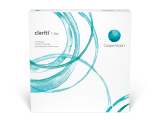Practitioners have long embraced the ocular health benefits of silicone hydrogel (SiHy) lens materials for their frequent replacement and extended wear patients. In the wake of Kathy Dumbleton’s study1 on the wearing habits of 1-day contact lens wearers, more and more practitioners now understand the importance of SiHy lenses for their 1-day wearers as well. In fact, Dumbleton’s multi-country study determined that daily disposable contact lens patients were wearing their lenses for an average of 15 hours per day, most wear them 7 days per week, and up to 75% of them admitted to napping in their lenses.*

But explaining Dk/t to patients can be difficult. While the idea of breathability is an easy one for patients to digest, it can be challenging to explain the advantages of one lens over another when recommending the SiHy upgrade. Oxygen maps can be a useful visual aid for explaining how a CooperVision 1-day product’s oxygen transmissibility compares to other lenses – and how they offer an excellent option for meeting Holden and Mertz’s2 established minimum dK/t value of 24.1 to avoid corneal hypoxia by giving visibility to the oxygen transmission across the lens. For instance, take a look at this oxygen map comparing the clariti® 1 day family of lenses to 1-Day Acuvue® Moist®.

Empowering your patients with the insight they need to make informed choices is an important step in successfully upgrading their 1-day material. The OptiExpert™ tool has oxygen maps like these to support your SiHy upgrade patient conversations.
Dumbleton KA et al. A multi-country assessment of compliance with daily disposable contact lens wear. Contact Lens & Anterior Eye 2013;36:304-32-12
Holden BA, Mertz GW. Critical oxygen levels to avoid corneal edema for daily and extended wear contact lenses. Invest Ophth Vis Sci. 1984;25:1161
*It is essential that patients follow eye care practitioners’ directions and all labeling instructions for proper use of lenses.





